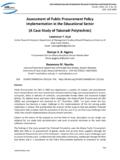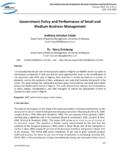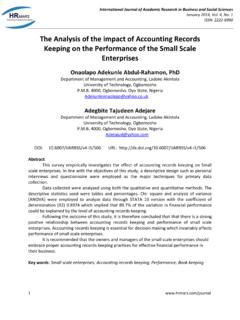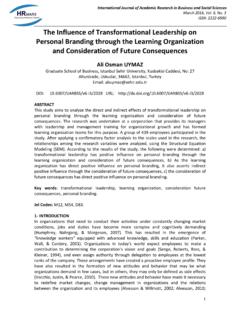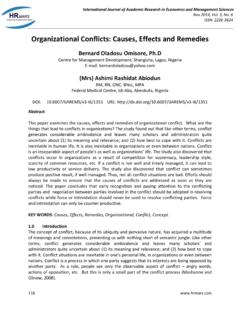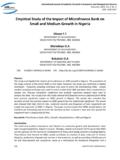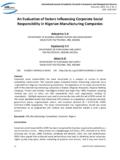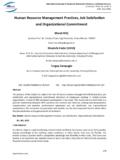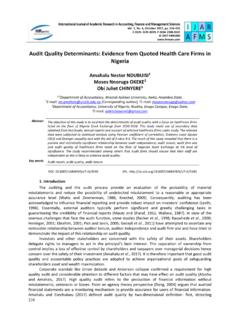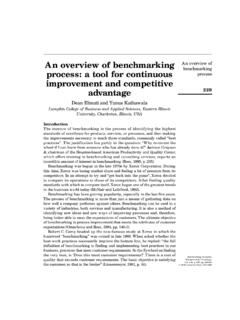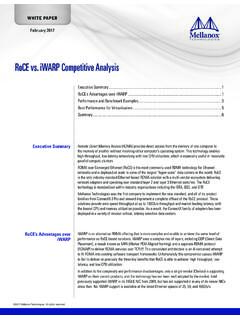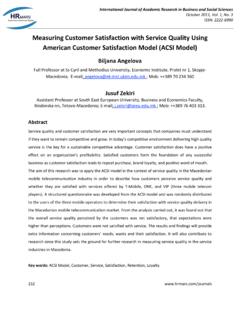Transcription of Analyzing the Impact of Supply Chain Management Practices ...
1 International Journal of Academic Research in Accounting, Finance and Management Sciences Vol. 4, , January 2014, pp. 1 15 ISSN: 2225-8329 2014 HRMARS Analyzing the Impact of Supply Chain Management Practices on Organizational Performance through Competitive Priorities (Case Study: Iran Pumps Company) Ebrahim KARIMI1 Mahmoud RAFIEE2 1 Industrial Engineering, Islamic Azad University Najafabad, Isfahan, Iran, 1E-mail: 2E-mail: Abstract Today organizations to encounter with environment of global Competition and for prosperity in this environment. We need to radical changes and creative in work. Supply Chain Management (SCM) is a thunderstruck of organization with higher and lower relationship that are involve in process and activities and like presentation product and services to final customers to create value.
2 So it is important in organization. So in this research the target is checking influence the adoption of Supply Chain Management Practices in organization performance through competitive priorities. Practices of data collection in this research is questionnaire that comprehensive Supply Chain Management questionnaire, organization performance and competitive priorities. This research according to application target and the methods. Scaling descriptive any correlation based on structural equation modeling (SEM). Research statistical communities apply all employees of Pump Iran that 483 of employees selected to random manner as members of sample. Research finding indicate that apply Practices Supply Chain Management influence in Iran pumps Company, according to competitive priorities.
3 Key words Supply Chain Management , performance, competitive priorities, Structural equation modeling DOI: URL: 1. Introduction Over the last decade the competitive landscape has shifted from lowest priced product, highest -quality or best-performing product to the ability to respond quickly to market needs and get the right product to the right customer at the right time. This shift toward speed has pushed organizations to compete with their entire Supply Chain . Consequently understanding and practicing Supply Chain Management (SCM) has become a mandate to compete and improve Supply Chain surplus in the global arena [1]. The early attempts of empirical research in SCM have been limited at developing instruments capable of measuring SCM Practices . Most recently, some researcher have focused their research efforts into exploring the relationship between Practices of SCM and organizational performance.
4 They have used financial and market criteria to operationalize organizational performance (return on investment, market share, profit margin on sales, the growth of return on investment, the growth of sales and the growth of market share). Also, they investigated the relationship among SCM Practices , operational performance and SCM-related organizational performance. These studies and others have produced various results due to operationalizing the performance of the organization subjectively and objectively. Supply - Chain driven organizational performance falls into three categories [2]. First, resource performance reflects value addition in the form of achieving efficiency. Second, output performance reflects value addition as the firm s ability to provide high levels of customer service.
5 Last, flexibility performance reflects value addition as the firm s ability to respond. As competition in the 1990s intensified and markets became global, so did the challenges associated with getting a product and service to the right place at the right time at the lowest cost. Organizations began to realize that it is not enough to improve efficiencies within an organization, but their whole Supply International Journal of Academic Research in Accounting, Finance and Management Sciences Vol. 4 (1), pp. 1 15, 2013 HRMARS 2 Chain has to be made competitive. The understanding and practicing of Supply Chain Management (SCM) has become an essential prerequisite for staying competitive in the global race and for enhancing profitably [3 6]. However, despite the increased attention paid to SCM, the literature has not been able to offer much by way of guidance to help the practice of SCM [8].
6 This has been attributed to the interdisciplinary origin of SCM, the conceptual confusion, and the evolutionary nature of SCM concept. There is no generally accepted definition of SCM in the literature [9, 10]. The concept of SCM has been involved from two separate paths: purchasing and Supply Management , and transportation and logistics Management [11]. According to purchasing and Supply Management perspective, SCM is synonymous with the integration of Supply base that evolved from the traditional purchasing and materials functions [17, 18]. In the perspective of transportation and logistics Management , SCM is synonymous with integrated logistics systems, and hence focus on inventory reduction both within and across organizations in the Supply Chain [7, 19 22]. Eventually, these two perspectives evolved into an integrated SCM that integrates all the activities along the whole Supply Chain .
7 The evolutionary nature and the complexity of SCM are also reflected in the SCM research. Much of the current theoretical/empirical research in SCM focuses on only the upstream or downstream side of the Supply Chain , or certain aspects/perspectives of SCM [23]. Topics such as supplier selection, supplier involvement, and manufacturing performance [24, 25], the influence of supplier alliances on the organization [26], success factors in strategic supplier alliances [27, 28], supplier Management orientation and supplier/buyer performance [29], the role of relationships with suppliers in improving supplier responsiveness [30], and the antecedence and consequences of buyer supplier relationship [31] have been researched on the supplier side. Some studies focus on the downstream linkages between manufacturers and retailers.
8 A few recent studies have considered both the upstream and downstream sides of the Supply Chain simultaneously. Explore the relationships between supplier Management Practices , customer relations Practices and organizational performance. The purpose of this studies therefore to empirically test a framework identifying the relationships among SCM Practices , competitive advantage and organizational performance. SCM Practices are defined as the set of activities undertaken by an organization to promote effective Management of its Supply Chain . The Practices of SCM are proposed to be a multi-dimensional concept, including the downstream and upstream sides of the Supply Chain . Operational measures for the constructs are developed and tested empirically, using data collected from respondents to a survey questionnaire.
9 Structural equation modeling is used to test the hypothesized relationships. It is expected that the current research, by addressing SCM Practices simultaneously from both upstream and downstream sides of a Supply Chain , will help researchers better understand the scope and the activities associated with SCM and allow researchers to test the antecedences and consequences of SCM practice. Further, by of faring a validated instrument to measure SCM Practices , and by pro viding empirical evidence of the Impact of SCM Practices on an organization s competitive advantage and its performance, it is expected that this research will offer useful guidance for measuring and implementing SCM Practices in an organization and facilitate further research in this area. The remainder of this paper is organized as follows. Section 2 presents the research framework, provides the definitions and theory underlying each dimension of SCM Practices , discusses the concepts of competitive advantage and organizational performance, and develops the hypothesized relationships.
10 The research methodology and analysis of results are then presented, followed by the implications of the study. 2. Research Framework Figure 1 presents the SCM framework developed in this research. The framework proposes that SCM Practices will have an Impact on organizational performance both directly and also in directly through competitive advantage. SCM practice is conceptualized as a four dimensional construct. The four dimensions are strategic supplier partnership, customer relationship, level of information sharing, quality of information sharing, and postponement. A detailed description of the development of the SCM Practices construct is provided in the following paragraphs. International Journal of Academic Research in Accounting, Finance and Management Sciences Vol. 4 (1), pp. 1 15, 2013 HRMARS 3 Figure 1.
